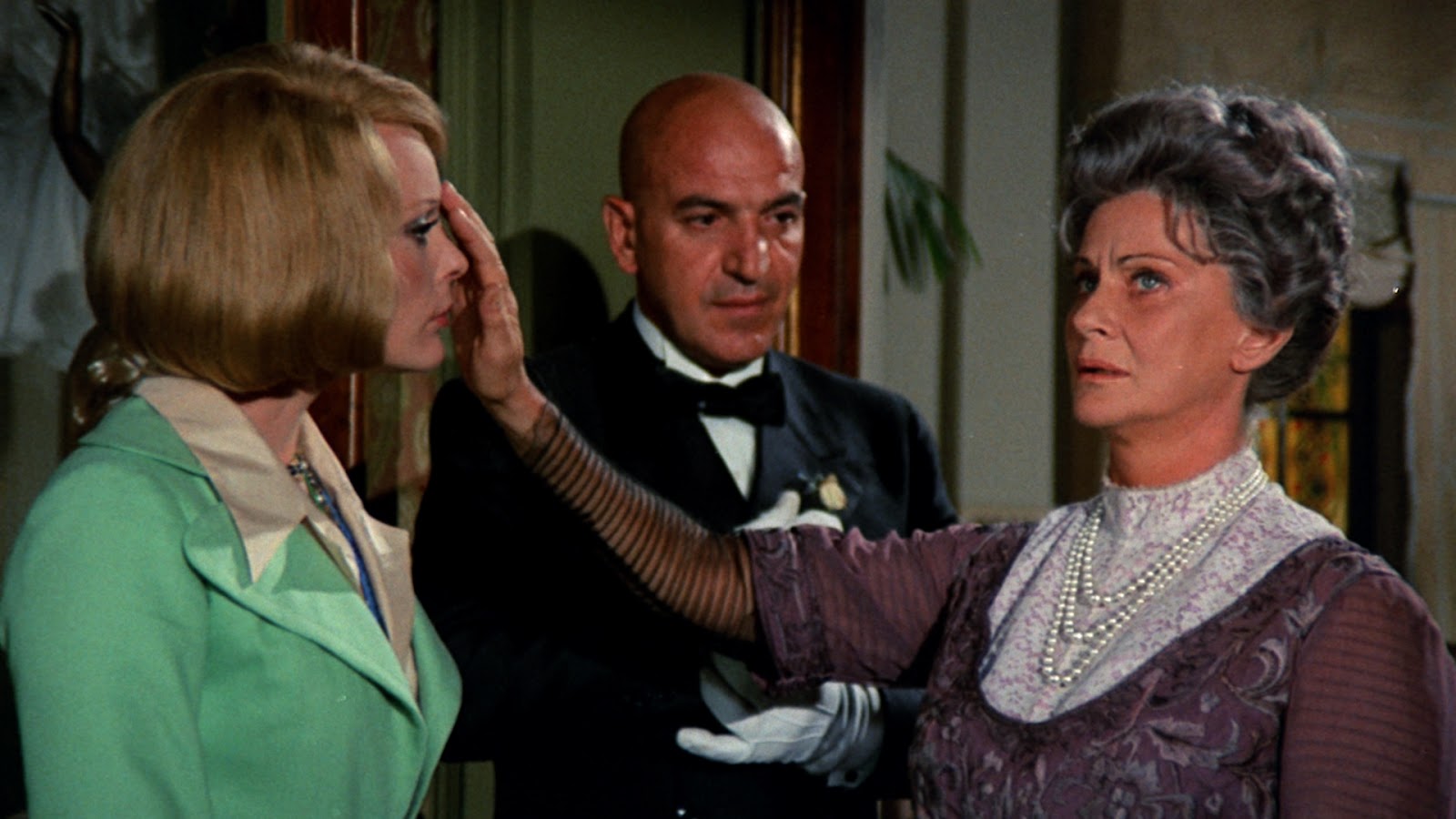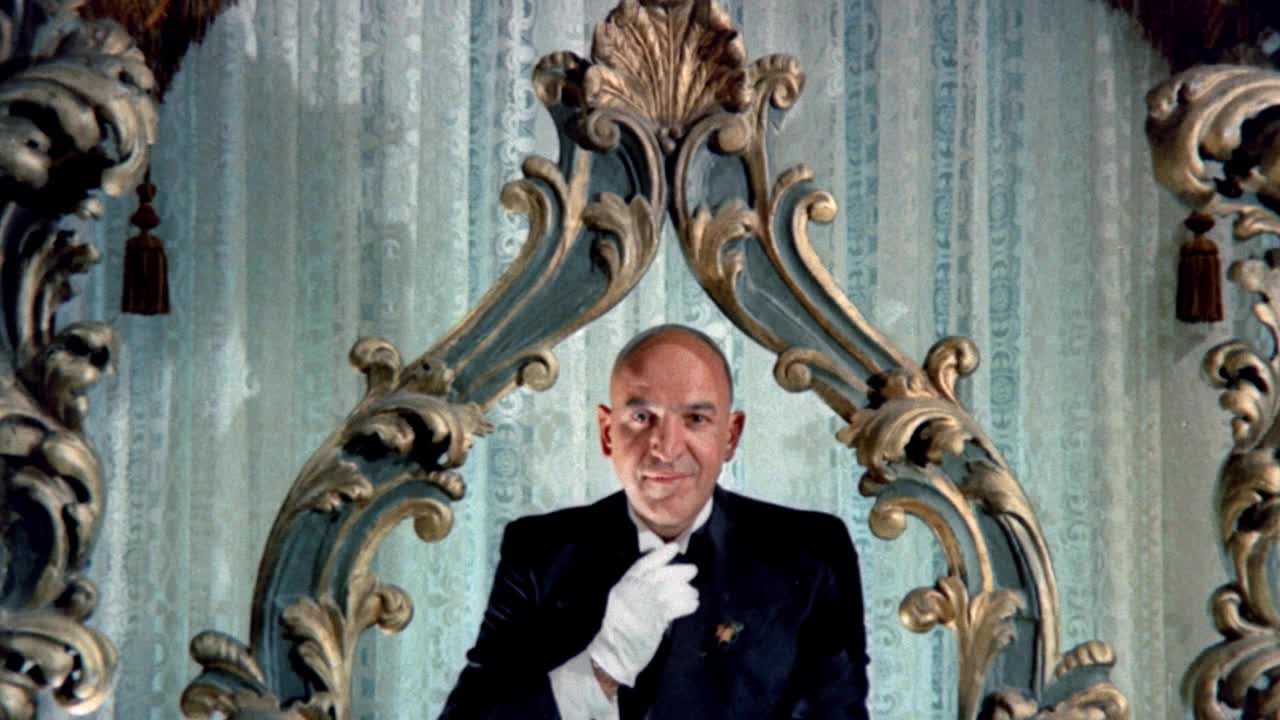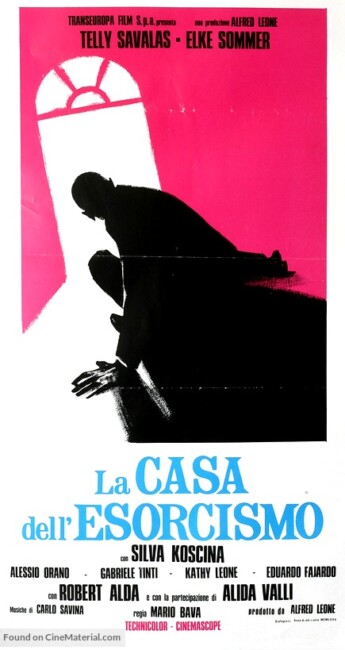aka House of Exorcism
(Lisa e il Diavolo)
Italy. 1972.
Crew
Director – Mario Bava, Screenplay – Mario Bava & Alfred Leone, Producer – Alfred Leone, Photography – Cecilio Paniagua, Music – Carlo Savina, Special Effects – Franco Tocci, Art Direction – Nedo Azzini. Production Company – Leone International Films, Inc.
Cast
Elke Sommer (Lisa Reiner), Telly Savalas (Leandro), Alessio Orario (Maximilian), Alida Valli (Countess), Sylva Koscina (Sophie Lehar), Eduardo Fajardo (Francis Lehar), Espartaco Santoni (Carlo), Gabriele Tinti (George), Kathy Leone (Lisa’s Friend)
Plot
Lisa Reiner visits a town with a tour group where they are shown a mediaeval fresco depicting The Devil. Lisa then wanders away from the party and becomes lost. She keeps encountering a strange bald-headed man who resembles the figure of The Devil in the fresco. As night falls, she is given a ride by Francis and Sophie Lehar and their chauffeur but the car breaks down outside the gates of a mansion. They are greeted by the butler Leandro, the bald-headed man she saw earlier. The handsome Maximilian is immediately taken with Lisa and persuades his mother, the blind Countess, to let them stay the night. However, once they are inside the house, strange things begin to happen. Lisa is haunted by her old flame Carlo who she may have killed. Meanwhile, a mysterious figure in red robes is killing the rest of the party.
Lisa and the Devil was the last great film from Italian horror director Mario Bava (1914-80). Bava made a name for himself with Black Sunday (1960), which created a sensation – indeed, created the 1960s genre of Gothic horror – that was much imitated over the next few years. After that, Mario Bava went onto create the giallo genre beginning with The Evil Eye (1962) and in particular Blood and Black Lace (1964), psycho-thrillers where the emphasis was on pure style, with beautiful women being murdered and highly contrived psychological explanations being offered for everything. (See below for a full list of Mario Bava’s other genre films).
Lisa and the Devil is one of the most fascinating oddities in Mario Bava’s oeuvre. Bava was riding on the international success of his previous film Baron Blood (1972). With the greater artistic freedom this offered, Bava conceived Lisa and the Devil as a much more personal work. Alas, after Bava completed Lisa and the Devil, it was declined by American distributors. Producer Alfred Leone then persuaded Bava to rework the existing film to capitalise on the success of The Exorcist (1973). Twenty minutes of running time were cut and new material was shot with star Elke Sommer, which included the addition of the new character of a priest played by Robert Alda to whom Elke describes the events of this film before he goes and exorcises the house. This was released internationally in 1975 under the title House of Exorcism.
As a result, the original version of Lisa and the Devil was never seen for many years – indeed, it was not screened as originally intended until after Mario Bava’s death in 1980. Bava would only make two other films, the non-genre thriller Rabid Dogs (1974) and the horror film Schock (1977). The original print of Lisa and the Devil was eventually restored and is now available on dvd.
It is an irony that Lisa and the Devil was packaged as a copy of The Exorcist. I have not seen the House of Exorcism version but it becomes apparent from watching Lisa and the Devil that the film as originally intended exists at almost 180 degrees remove from the typical Exorcist copy. Where The Exorcist and its copies were all about shock effect, Lisa and the Devil is almost a dreamy arthouse haunted house story. The film was shot in Toledo, Spain, and Bava, a former cinematographer, makes maximum pictographic use of locations. It takes place amid gorgeously extravagant surroundings – an old-fashioned saloon car driving through the mist; the grounds of the estate containing pagodas filled with classic statues and ornate bridges over small streams; demon statues and blank-faced mannequins balefully looking on inside the house; or the way that Bava effortlessly creates something ominous as Elke Sommer becomes lost in the warren of tight streets in the old town as the film opens.

Bava has clearly obtained the use of a classic house and he and his set designers make exquisitely dressed use of it. Every shot seems to open with a focus on a statue or some piece of artfully designed furniture, which Bava then pulls back/pans away from into the scene itself. Indeed, it is the house and its grounds that become the real star of the show. There are all the usual Bava-esque show-off shots – a grandfather clock with a giant foregrounded pendulum; a love scene reflected off a mirrored cigarette case; Telly Savalas’s face reflected off a spilt glass of red wine or the pool of an ornate fountain.
There is a striking dream scene where Elke Sommer makes love to Alessio Orario with his wife’s corpse lying on the bed next to her and an equally exquisite scene where she wakes up and finds the house around her is now a series of beautifully overgrown ruins where the foliage intrudes into the bedroom.
The problem for distributors may also have been that it takes some time for the film to get to Mario Bava’s trademark murder set-pieces – it is not until the halfway point that we get to the memorable scene where the wife (Sylva Koscina) runs the husband (Eduardo Fajardo)’s body over in the car.
The downside of all of this is that Lisa and the Devil makes almost no sense at all. Mario Bava was never one for plots and Lisa and the Devil is surely this at an absolute extreme. Is Telly Savalas meant to be The Devil as the opening suggests? If so, he never seems to do anything other than stand around being a butler and cheerfully helping clear up the corpses, although the end coda aboard the plane suggests he has some kind of supernatural power. Is Elke Sommer’s ex Carlo dead – did she accidentally kill him at the start? Is he still alive or is it his ghost that keeps popping up throughout?

The script also seems undecided as to whether Lisa and the Devil is a standard giallo psycho-thriller concerning a psycho unnaturally obsessed with his dead wife wandering around killing people while dressed in scarlet robes or else some type of haunted menace. The end even more confusingly indicates that everything was a dream had by Elke Sommer and that nobody has lived inside the house for a century. Equally, the coda with Elke Sommer departing the house and getting aboard a plane to find it filled with mannequins and a smiling Telly Savalas as the pilot makes no sense either.
The most famous name to emerge out of Lisa and the Devil was Telly Savalas. Savalas had been acting since 1960 with roles in films such as Birdman of Alcatraz (1962), Cape Fear (1962), The Dirty Dozen (1967) and as Blofeld in the James Bond film On Her Majesty’s Secret Service (1969). He had previously entered the horror genre in the entertainingly absurd Spanish film Horror Express (1972). However, Telly Savalas’s signature role would not come until the year after this when he was cast as the title character in the tv series Kojak (1973-8). There are interesting connections between Lisa and the Devil and Kojak. One of these is that it was here that Telly Savalas premiered the idiosyncrasy of sucking lollipops that became a regular feature of the character of Kojak – the reason for such being that Savalas had apparently just quit smoking and needed an oral plug. He even has his trademark line “Would you like a lollypop, madam?” here at one point. He delivers an amusing performance, walking through the film blithely unfazed, while breaking the legs of corpses and the like, although this becomes increasingly campier in the latter half.
Mario Bava’s other genre films are:- uncredited co-direction of Riccardo Freda’s I Vampiri (1957); the Gothic classic Black Sunday/The Mask of the Demon/The Revenge of the Vampire Woman (1960); the Greek muscleman fantasy Hercules in the Center of the Earth/Hercules vs the Vampires (1961); the giallo The Evil Eye (1962); the Gothic horror anthology Black Sabbath (1963); the Gothic horror Night is the Phantom/The Whip and the Body/What? (1963); the giallo Blood and Black Lace (1964) the Gothic Kill Baby … Kill/Curse of the Dead/Curse of the Living Dead/Operation Fear (1965); the sf/horror film Planet of the Vampires (1965); the spy comedy Dr Goldfoot and the Girls Bombs (1966), Bava’s worst film; the masked super-thief film Danger Diabolik (1967); the giallo Five Dolls for an August Moon (1970); the giallo Hatchet for a Honeymoon/Blood Brides (1971); the giallo Twitch of the Death Nerve/Bay of Blood/Carnage (1971); the Gothic Baron Blood (1972); and the possession film Schock/Beyond the Door II (1977).
Trailer here


